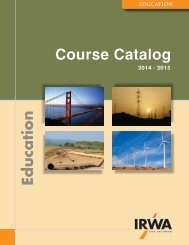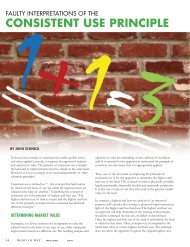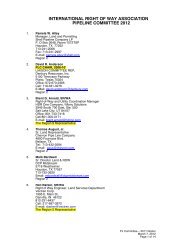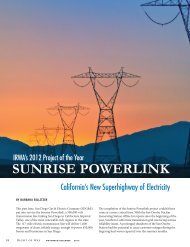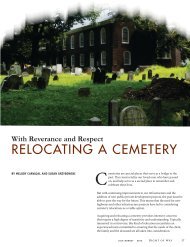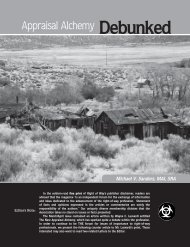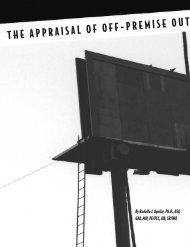The Appraisal of Easements - International Right of Way Association
The Appraisal of Easements - International Right of Way Association
The Appraisal of Easements - International Right of Way Association
- No tags were found...
You also want an ePaper? Increase the reach of your titles
YUMPU automatically turns print PDFs into web optimized ePapers that Google loves.
FEATURE<strong>The</strong> <strong>Appraisal</strong> <strong>of</strong> <strong>Easements</strong>By Albert N. Allen, SR/WAIn recent years, the increased level <strong>of</strong> easement acquisition, particularly by energy andtelecommunication companies, has prompted a number <strong>of</strong> reasons for easement appraisalto include proposed easement acquisition, appraisal <strong>of</strong> property encumbered with one ormore easements, and analysis <strong>of</strong> property sales already encumbered with easements. Thisarticle primarily focuses on easement acquisition across individual properties: themethodology rather than application. <strong>The</strong> scope <strong>of</strong> the article also includes somebackground consisting <strong>of</strong> definitions, a discussion <strong>of</strong> proper easement valuationmethodology, and finally some comments on misused alternative methodology.BACKGROUNDA brief discussion <strong>of</strong> basic terms related to the eminent domainvaluation framework will probably prove helpful before addressingeasement valuation methodology. <strong>The</strong>re are many excellent sources forvaluation-related definitions, and several have been included in thereferences at the end <strong>of</strong> this article. No attempt has been made to advanceprecise definitions in this article, but rather to relate the terms to eachother and to show how they fit within the easement valuation framework.MARKET VALUE — <strong>The</strong> appraiser should be aware <strong>of</strong> the marketvalue definition <strong>of</strong> the particular jurisdiction <strong>of</strong> the subject property. Anyproper definition will include the willing seller/willing buyer concept. <strong>The</strong>courts are seeking just compensation and market value is generallyaccepted as a basis for just compensation. When appraising the impact <strong>of</strong>an easement on a particular property, care should be exercised not to arriveat a conclusion <strong>of</strong> value other than market value. Market value is relatedto the value <strong>of</strong> the subject property itself (in rem) to typical marketparticipants and not to the individuals or entities (in personam) that ownthe property.Examples <strong>of</strong> other types <strong>of</strong> value include use value (value particular tothe owners <strong>of</strong> the property) usually associated with a special use property,and investment value (value to the buyer).HIGHEST AND BEST USE — This is probably the single mostimportant appraisal principle and is fundamental when estimating marketvalue. Land is always appraised based on its highest and best use astheoretically vacant and available for development at the date <strong>of</strong> theappraisal. <strong>The</strong> existing (current) use, particularly <strong>of</strong> improved property, isnot necessarily the standard; rather it is the physically possible,appropriately and legally supported, financially feasible, and resulting in40 NOVEMBER/DECEMBER 2001 ✦ right <strong>of</strong> way
the highest value <strong>of</strong> the land as <strong>of</strong> the date <strong>of</strong> valuation. A potential(future) highest and best use is not the standard used unless that use isreasonably probable. Highest and best use concerns the use <strong>of</strong> land andnot the owners or buyers <strong>of</strong> property. Business value is outside <strong>of</strong> thescope <strong>of</strong> highest and best use.WHOLE PROPERTY — Sometimes referred to as the entirety, thelarger parcel, or the parent tract. Some appraisers distinguish betweenthe three. <strong>The</strong> term whole property asused in this report means a propertyunder a single ownership, physicallycontiguous and with one highest and bestuse throughout. Cases <strong>of</strong> commonownership, physical contiguity and morethan one highest and best use indicatemore than one economic unit and thus,more than one whole property. <strong>The</strong>market value <strong>of</strong> the whole property placesthe ceiling on just compensation. That isto say, the market value <strong>of</strong> a part takencannot exceed the market value <strong>of</strong> thewhole property, although the taking canresult in damages in excess <strong>of</strong> the marketvalue <strong>of</strong> the partial acquisition.PARTIAL ACQUISITION — Alsovariously referred to as the part taken,take, or partial take. A fee taking involvesall <strong>of</strong> the rights <strong>of</strong> ownership; however, aneasement involves a partial taking <strong>of</strong>rights, and, in many cases, the interesttaking involves but a portion <strong>of</strong> the totalproperty. Different kinds <strong>of</strong> partialtakings include 1) the fee taking <strong>of</strong> a part<strong>of</strong> the total property; 2) an easementtaking affecting the total property; and 3)an easement taking <strong>of</strong> part <strong>of</strong> the totalproperty.An easement acquisition is always apartial acquisition. Even if the proposedeasement physically covers the entiresubject whole property, the underlyingfee estate is not acquired. <strong>The</strong> underlyingfee owner still has a beneficial interest inthe property. A partial acquisition caninvolve physical property or legal rights(such as access rights), or both. <strong>The</strong>appraisal <strong>of</strong> easements requiresidentification <strong>of</strong> the type <strong>of</strong> easement andthe physical parts <strong>of</strong> the total property affected.REMAINDER PROPERTY — <strong>The</strong> remainder property includes thoseportions <strong>of</strong> the total property not taken plus the property rightsremaining to the owners <strong>of</strong> the easement area itself. For example, apipeline easement across a farm will leave the landowner with land areasnot within the easement, plus the right to use the surface area <strong>of</strong> theeasement area after construction for crops. As a result <strong>of</strong> some easementacquisitions, the remainder property may have a different highest andbest use than that <strong>of</strong> the original whole property.RIGHT OF WAY — As used in this article, right <strong>of</strong> way will refer tothe area within the boundaries <strong>of</strong> the easement in which the utility,pipeline, or telecommunication facility is installed. For example, thepipeline right <strong>of</strong> way width may be 50 feet. A right <strong>of</strong> way may be acrossa particular property. A right <strong>of</strong> way can also be a route across manydifferent properties, as in the case <strong>of</strong> a pipeline or a fiber optic line. A rightFEATUREIn the valuation<strong>of</strong> easementsfor publicacquisition, themeasure <strong>of</strong> valueis always the lossin the value <strong>of</strong>the burdenedproperty, notthe value <strong>of</strong>the easementto the taker.<strong>of</strong> way can also include fee simple property. A right <strong>of</strong> way should not beconfused with an easement. In most cases, a right <strong>of</strong> way will crossmultiple properties and will consist <strong>of</strong> several easements. An easement isunique to one property. Both terms, as they relate to the subject property,should be discussed within the appraisal report. Another commonmistake is to confuse a right <strong>of</strong> way with a corridor. A corridor is alwaysa right <strong>of</strong> way, but a right <strong>of</strong> way is not necessarily a corridor. Corridorsare discussed later in this article.EASEMENT — An easement is aspecifically defined interest (estate) inproperty and is owned by someone otherthan the owner <strong>of</strong> the underlying feesimple interest. It is a dominant estateand the underlying fee is a servient estate.<strong>The</strong> easement document specificallydelineates what property rights areinvolved and should be included in theappraisal report. No two easements areexactly alike. Each easement is associatedwith a particular property and is uniquefrom other easements on that propertyand to easements situated on otherproperties. <strong>Easements</strong> are not a type <strong>of</strong>highest and best use. An individualeasement is not a right <strong>of</strong> way system orcorridor.USER IMPROVEMENTS — <strong>The</strong>seare the physical improvements orstructures placed within the right <strong>of</strong> waysuch as a pipeline, electric transmissionline, telecommunications cable, etc. Thisfacility may be situated on a singleproperty or may extend across manyseparate properties.<strong>The</strong> user improvements in easementareas are owned and operated bysomeone other than the underlying feeowner. Any value, cost, pr<strong>of</strong>it or revenuefrom operation <strong>of</strong> the user improvementsgoes to its owner and not to theunderlying fee owner. Revenue fromoperating the infrastructure is a businessventure separate from the value <strong>of</strong> theland burdened by an easement.PROJECT INFLUENCE — In thepartial taking <strong>of</strong> a right <strong>of</strong> way for a givenproject, the purpose <strong>of</strong> the project andthe proposed user improvements can impact the value <strong>of</strong> the remainderproperty. It can lower the value <strong>of</strong> the remainder (damage), raise the value(benefit), or have no impact on the remainder value. <strong>The</strong> projectinfluence rule says that any impact on value affects only the remainderand should not be considered when appraising the whole property value.Valuation <strong>of</strong> the whole property and the partial acquisition is estimatedbefore considering the project influence. <strong>The</strong> remainder property isvalued after considering the impact <strong>of</strong> the project.CORRIDOR — Corridors should not be confused with easements. Acorridor is a property use rather than an estate. Stated another way, acorridor is a type <strong>of</strong> highest and best use, while an easement is generallyan estate or interest in land. A highest and best use as a corridor is marketdriven as opposed to an arbitrary delineation, and the reasonableprobability <strong>of</strong> users is necessary.right <strong>of</strong> way ✦ NOVEMBER/DECEMBER 2001 41
H.C. PECK & ASSOCIATESINC.A FULL SERVICE NATIONALRIGHT-OF-WAY COMPANYHELEN C. PECK, PresidentMarket Center Building, 1624 Market St., Suite 205Mailing Address: P.O. Box 480306, Denver, CO 80248-0306(303) 623-6112 • Fax (303) 623-6301www.hcpeck.comFEATURE<strong>Right</strong>s <strong>of</strong> way across an individual property are typically in the form <strong>of</strong> aneasement; however, the user may own in fee some portions in a given length <strong>of</strong>right <strong>of</strong> way (across multiple properties). Only when the land across a given length<strong>of</strong> right <strong>of</strong> way is in the absolute control <strong>of</strong> a one entity, may the length be definedas a right <strong>of</strong> way corridor (and this assumes that other tests are met as well). Insome circumstances, the individual existing rights <strong>of</strong> way easements are not in thecontrol <strong>of</strong> an individual entity, and changes and sale <strong>of</strong> the corridor for additionalusers is not possible without the additional consent <strong>of</strong> the individual owners <strong>of</strong> theunderlying fee simple estate. For example, if a railroad is situated within a physicalcorridor but owns only the right to use as a railroad, and the individual fee ownerscontrol other uses (such as laying a pipeline or fiber optic line), then that right <strong>of</strong>way cannot be defined as a marketable corridor in an economic sense.A corridor has a number <strong>of</strong> characteristics. Any corridor connects importantdemand points while an easement extends to the boundaries <strong>of</strong> only one property.A corridor avoids congestion to the extent that it bypasses many properties,allowing a user to avoid buying right <strong>of</strong> way from many different owners. That isto say a corridor provides a distance advantage due to transport across manyownerships. <strong>The</strong> corridor owners provide services such as engineering,maintenance and surveillance. Corridors are typically marketed as an entity.Owners <strong>of</strong> corridors rent or sell right <strong>of</strong> way within the corridor to users whowish to place their user improvements within it. However, the physical corridor isnot classified as a right <strong>of</strong> way corridor unless the rights to use can be obtainedfrom a single entity without the necessity <strong>of</strong> getting also the same rights from allthe basic fee owners <strong>of</strong> the land. <strong>The</strong>re is considerable literature on the subject <strong>of</strong>corridor valuation and some has been included in the bibliography.VALUATION CONSIDERATIONS<strong>The</strong> proper valuation methodology for easements is the “before and after” rule.A variation <strong>of</strong> this rule is the “take plus damages” rule. Generally, case law andappraisal literature support this methodology. Strictly speaking, the appraiser doesnot appraise an easement but rather measures the impact <strong>of</strong> the easement on theburdened property. <strong>The</strong> measure and impact (value) <strong>of</strong> an easement is the loss invalue to the remainder property after imposition <strong>of</strong> theeasement. This diminution is comprised <strong>of</strong> both theeasement acquisition and damage (if any) to theremainder. Different jurisdictions have different lawsgoverning the valuation <strong>of</strong> partial takings and theappraiser should be careful to use that methodologyapplicable in the subject property’s jurisdiction.In the valuation <strong>of</strong> easements for public acquisition,the measure <strong>of</strong> value is always the loss in the value <strong>of</strong>the burdened property, not the value <strong>of</strong> the easementto the taker. <strong>Appraisal</strong> methodology is focused on themarket value <strong>of</strong> the property and should beconsistently applied. <strong>The</strong> valuation methodologyused should not vary regardless <strong>of</strong> the nature <strong>of</strong> theproposed project, who the buyers will be, or who theowner is. Additionally, it should not vary whether agovernmental agency is involved or if it takes place inthe private sector.VALUATION OF THE WHOLE PROPERTY — <strong>The</strong>whole property is appraised before any consideration<strong>of</strong> the proposed project. <strong>The</strong> whole property is notburdened by the proposed project in the beforescenario and the market data collected for the wholeproperty value estimate should not reflect any projectinfluence.VALUATION OF THE PARTIAL ACQUISITION —<strong>The</strong> proposed acquisition area to be burdened by theeasement is appraised in the before situation and willhave the same per unit value as that <strong>of</strong> the wholeproperty. All easement acquisitions are partial42 NOVEMBER/DECEMBER 2001 ✦ right <strong>of</strong> way
Advertise in right <strong>of</strong> waycall IRWA Headquarters at (310) 538-0233 for more information.COORDINATED LAND& RIGHT OF WAYSERVICESSINCE 1958acquisitions because some beneficial interest remainswith the underlying fee owner. Accordingly, the value<strong>of</strong> the proposed easement impact on the remainderwill be less than the value <strong>of</strong> the fee simple that itburdens, and cannot be more. <strong>The</strong> market value <strong>of</strong>the easement acquisition is directly related to themarket value <strong>of</strong> the property it burdens. If thepurchase price <strong>of</strong> an easement exceeds that <strong>of</strong> theunderlying fee simple value, this is an indication <strong>of</strong> thepresence <strong>of</strong> other considerations, such as damages tothe remainder, business decisions, time restraints,administrative settlements, improvements within theacquisition area, unusual physical characteristics,engineering factors, etc. If the area <strong>of</strong> the proposedeasement were worth more on a per unit basis than thevalue <strong>of</strong> the fee simple estate, then it would follow theproperties burdened with easements would sell formore than properties having no easements. <strong>The</strong>market does not bear this out.VALUATION OF THE REMAINDER — <strong>The</strong>remainder is appraised in the after scenario because itis now burdened with the easement. <strong>The</strong> remainderconsists <strong>of</strong> all property outside <strong>of</strong> the acquisition areaand the underlying fee simple interest. Paired salesanalysis is the proper way to measure the impact <strong>of</strong> theeasement. By comparing properties similar to thesubject with an easement to similar properties withoutan easement, an estimate <strong>of</strong> the differences can beabstracted.TOTAL BEFORE AND AFTER METHOD — Whenthe law <strong>of</strong> the subject property’s jurisdiction requires abefore and after valuation, the appraiser performs anappraisal <strong>of</strong> the property before considering the impact<strong>of</strong> the take and the project. Next a new appraisal ismade <strong>of</strong> the remainder property under the theoreticalassumption that the proposed project has beencompleted. <strong>The</strong> appraiser takes into account in theafter value the impact upon value <strong>of</strong> the use <strong>of</strong> theeasement area by the project and the benefits <strong>of</strong> theeasement area remaining to the underlying fee owner.Also taken into consideration is the impact on the Feasibility Studies <strong>Right</strong> <strong>of</strong> <strong>Way</strong> Location Title Search <strong>Appraisal</strong>s Preliminary Survey <strong>Right</strong> <strong>of</strong> <strong>Way</strong> Negotiation Relocation Assistance Utility Relocation Construction Survey Settlement <strong>of</strong>Construction Damages Computerized Project Records Project ManagementFIELD SERVICES, INC.800-447-9191Corporate Offices:P.O. Box 35666 • Tulsa, Oklahoma 74153-0666(918) 494-7600 • FAX: (918) 494-7650www.ufsrw.comAN EQUAL OPPORTUNITY EMPLOYERright <strong>of</strong> way ✦ NOVEMBER/DECEMBER 2001 43
FEATUREremainder <strong>of</strong> the taking. Sales <strong>of</strong> properties burdened by a similareasement are compared with similar properties not affected by the sametype <strong>of</strong> easement.ALTERNATIVE METHODOLOGIESOn occasion valuation methodologies other than the “before and after”method are advocated both in practice and in appraisal literature. <strong>The</strong>sealternative methodologies have arisen in part from the hectic nature <strong>of</strong>utility right <strong>of</strong> way (telephone, electricity, pipeline, fiber optic, etc.)acquisitions in recent years and some have serious flaws. Three <strong>of</strong> thesealternative methods will be discussed: use <strong>of</strong> easement transactions ascomparables, linear rules <strong>of</strong> thumb, and incorrect use <strong>of</strong> corridorvaluation theory.EASEMENT TRANSACTIONS COMPARABLES — Generally speaking,easement transactions are not reliable for use as comparable data andshould not be used when appraising the impact <strong>of</strong> an easement on theburdened property. Even though the use <strong>of</strong> easement transactions seemsvery straight forward, there are a number <strong>of</strong> reasons why they should notbe used to estimate market value.<strong>Easements</strong> are not economic units in and <strong>of</strong> themselves. An economicunit must stand alone on its own. <strong>The</strong>y are not traded individually on theopen market. A user purchases easements in order to assemble a systemand most easement transactions represent gain to the buyer as opposed toloss in value to the burdened property. Because the buyer is puttingtogether a right <strong>of</strong> way system, many non-realty considerations could beinvolved in an easement transaction including administrative costs,engineering factors, project timing and other business decisions. Forexample, a natural gas supplier facing a contractual deadline might pay aninflated price for a particular easement in order to complete the project.Another example would be when valuing partial acquisitions for a roadwideningproject; sales <strong>of</strong> strips <strong>of</strong> land to the condemnor on other roadprojects are not used as comparable sales. <strong>The</strong> appraisal methodologyshould be consistent regardless <strong>of</strong> the type <strong>of</strong> project.For some types <strong>of</strong> easements, such as those acquired by utilitycompanies for electric, telephone, cable lines and pipelines, there may bean established going rate per pole, per line-mile, per rod, and the like. Inappraising a similar type <strong>of</strong> easement for government acquisitions, theappraisal should not be based on such going rates but should be basedupon the usual “before and after” appraisal method. It therefore goeswithout saying that sales <strong>of</strong> easements based on such measures cannot beconsidered valid comparable sales.<strong>The</strong> use <strong>of</strong> easement sales introduces project influence (an afterscenario) to the before valuation. Any valuation <strong>of</strong> an easement impactshould be in the after situation. In the before scenario, there is noeasement. Using easement transactions as comparables might indicate apre-determined opinion that the proposed easement area represents aneconomic unit (separate highest and best use). <strong>The</strong> probability <strong>of</strong> aneasement being placed on a particular property at the precise locationacross the property in anticipation <strong>of</strong> a project in the future is probablyremote. Accordingly, the reasonable probability component <strong>of</strong> highestand best use is violated.Easement transactions are complex and obtaining all <strong>of</strong> the informationnecessary to make a direct comparison to the subject easement is extremelydifficult. Confirmation by the appraiser <strong>of</strong> the amounts paid for eacheasement along a right <strong>of</strong> way project is very difficult. Even if the salesprices are available, identifying and abstracting the various components <strong>of</strong>each transaction such as land value, damages to the remainder, businessdecision, etc. are hard to obtain. Accordingly, the comparison is usuallyunreliable.Each burdened property is unique. An easement across one propertywill probably reflect a different impact when compared to the impact <strong>of</strong> aneasement acquisition on the subject property. For example, there may havebeen improvements within the easement areas <strong>of</strong> one easement sale andnone in the subject easement area. <strong>The</strong>re may be damages to the remainderas a result <strong>of</strong> the easement on one property and no damages to theremainder on the subject property. <strong>The</strong> highest and best use <strong>of</strong> oneproperty may be different than that <strong>of</strong> the subject whole property.Each easement is unique. For example, one easement may involve a 50-foot right <strong>of</strong> way compared to only 30-feet for the subject easement.Another easement may extend diagonally across one property unlike thesubject easement that may extend along the property boundary. Oneeasement may have a term <strong>of</strong> ten years while the subject easement mayhave an indefinite term.Each user improvement is unique. <strong>The</strong> size <strong>of</strong> the pipeline, the number<strong>of</strong> pipelines allowed, the product, etc. all may differ between one easementtransaction and the facility to be built on the subject easement area. <strong>The</strong>se44 NOVEMBER/DECEMBER 2001 ✦ right <strong>of</strong> way
differences are important because the potential for damages to therespective remainders may differ between the easement transactions usedfor a comparable and the subject easement.Each purchase is unique to that buyer. It is difficult to compare atransaction involving one buyer with a particular set <strong>of</strong> needs andobjectives to another situation involving another buyer with a differentscenario <strong>of</strong> potential gain.<strong>The</strong> most compelling reason that the prices paid for rights <strong>of</strong> way shouldnot be the basis <strong>of</strong> establishing market value <strong>of</strong> an easement is that suchacquisitions are not made by a willing buyer and willing seller. <strong>The</strong> utilityor pipeline company is a forced buyer and the sellers are under the threat<strong>of</strong> condemnation. Even if the purchaser does not have the power <strong>of</strong>eminent domain, they are still a forced buyer. Such sales do not representopen market value.LINEAR RULES OF THUMB — Although in practice, easementpurchases are <strong>of</strong>ten made based on linear units <strong>of</strong> value such as, per rod, permile, per foot, etc., this is not appropriate appraisalmethodology. As pointed out earlier, each easement isquite unique and a linear measurement (per unitexpression <strong>of</strong> value) does not take into account thedifferences between properties. An easement across anindividual property is only one component <strong>of</strong> a right <strong>of</strong>way project that may extend for many miles acrossdozens, if not hundreds, <strong>of</strong> individual properties. Oftenthe linear measurement represents value to the buyer. Tothe extent that the buyer is assembling a right <strong>of</strong> waysystem, prices paid for individual easements may reflect abusiness decision rather than a market value decision.Accordingly, the linear measurement will usuallyrepresent a use value such as investment value, rather thanmarket value.IMPROPER USE OF CORRIDOR THEORY — Inthose cases where highways, pipelines, electrictransmission lines extend from one point to another,there obviously exists a physical corridor. <strong>The</strong> user <strong>of</strong> theland areas in the physical corridor may own fee title tothe lands in the right <strong>of</strong> way, for example, the statehighway department. In such cases, the land from onepoint to another is a true, saleable or rentable right <strong>of</strong>way corridor providing the user the right to sell or leaserights to others to place their improvements, such as acoaxial cable, in the corridor. In some cases, the land wasacquired from the landowners for the sole purpose <strong>of</strong> thehighway and the state may not have the right to sell orlease the restricted corridor to others.<strong>The</strong>re are instances where railroads, with fee title tothe right <strong>of</strong> way, abandon their service to a particularright <strong>of</strong> way and then sell or lease the land to others.Roads owned in fee may be undedicated and the feelands become available for sale or lease to others.Frequently, there is no demand for the rights <strong>of</strong> wayabandoned by the utility or railroad and the land isdivided and sold (where possible) to the adjacent owners.Where railroads own the fee title to their right <strong>of</strong> way,they may be able to lease or sell portions <strong>of</strong> the right <strong>of</strong>way to others such as a pipeline. Interstate highwaysprobably are the largest supply <strong>of</strong> true, merchantablecorridors.<strong>The</strong> methodology <strong>of</strong> appraising true, saleable right <strong>of</strong>way corridors depend upon a demand by some entityand the ability <strong>of</strong> the buyer to pay. When a demandFEATUREexists, the lower limit <strong>of</strong> value typically is the across the fence unit valueadjusted down for the property rights retained by the seller. <strong>The</strong> upper limitis usually the across the fence land value sometimes including an increment(usually a multiple) above the across the fence land value as adjusted forplottage.When the ownership and control <strong>of</strong> additional usage <strong>of</strong> a physical right<strong>of</strong> way is vested in a number <strong>of</strong> landowners in addition to the easementholder for the original use, there is no merchantable right <strong>of</strong> way corridor.It is improper to use the “corridor concept” in those cases <strong>of</strong> physicalcorridors since there is no savings <strong>of</strong> time and expense. <strong>The</strong> existinglandowners may even demand more compensation than owners in a newright <strong>of</strong> way.<strong>The</strong> attempt to place a “corridor” premium on proposed individualeasements because they are a part <strong>of</strong> or adjacent to an existing right <strong>of</strong> way,by classifying it as “corridor value” is incorrect. Several courts haveconfirmed this.Who ya gonna call?Resources, Responsiveness, ResultsJeff Richardson, PresidentOakbrook Terrace, ILPh: 630-932-7000Fax: 630-932-7010jeffr@salemland.com<strong>The</strong> Land Acquisition ExpertsWhen the call goes out,When it’s got to be done right,When it's got to be done on time,on budget, and on target...You need a hero.Experienced, career land executiveswho have been there, done thatand bought the Land <strong>Right</strong>s.So send out the signal...Help is on the way!Mark Malacord, Vice PresidentHouston, TXPh: 713-270-9298Fax: 713-270-9780markm@salemland.comwww.salemland.comright <strong>of</strong> way ✦ NOVEMBER/DECEMBER 2001 45
FEATURESUMMARYIn the final analysis, the traditional, land-based, before and aftermethodology is the best measure <strong>of</strong> the impact <strong>of</strong> an easement on aparticular piece <strong>of</strong> property. If market value is being sought, then theimpact on the value <strong>of</strong> the property and not gain to a buyer (whetherindividual or entity) is the appropriate measure. To use other techniqueswill almost invariably lead to an estimate <strong>of</strong> some value other than marketvalue. This is a particularly important consideration in the eminentdomain framework.<strong>The</strong> market value <strong>of</strong> easements does not relate to the value to the user.<strong>The</strong> “use” <strong>of</strong> highest and best use is the economic use <strong>of</strong> the propertywithout regard to the benefits to the condemnor. Typically, the partialacquisition may involve specifically defined interest over the total property,such as an avigation easement covering the entire property; or, it mayinvolve certain rights to merely part <strong>of</strong> the whole property, such as adriveway access.<strong>The</strong> market value <strong>of</strong> a corridor can be totally owned in fee by a singleFeasibility StudiesAcquisitionTitle ServicesAsset Management<strong>Appraisal</strong>Survey ServicesRelocation AssistanceGIS/CADD MappingProject ManagementArchaeological &Environmental ServicesCORPORATE HEADQUARTERS3501 N. Campbell Avenue • Suite 104Tucson, Arizona 85719voice 520/319-2106 • tollfree 800-887-0847fax 520/323-3326email/website • tierra-row.comBRANCH OFFICESScottsdale, Arizona • Denver, ColoradoOntario and Sacramento, CaliforniaPort Angeles, Washingtonentity, such as a railroad or state highway, or, the physical corridor can be anumber <strong>of</strong> parcels with the underlying fee owned by individual propertyowners. <strong>The</strong>re may be a plottage increment above the “across the fence”value when portions <strong>of</strong> the total corridor can be sold or rented to others bya single owner; however, there is no rationale for a value increment whenevery property in the corridor must be acquired from the individual owners.In the direct sales comparison approach, transactions involving rights<strong>of</strong> way acquired by others are not considered valid because they are notopen market transactions. Such acquisitions are by a condemnor forced toacquire and by a condemnee forced to sell under the threat <strong>of</strong> eminentdomain. <strong>The</strong> price per rod, per acre, or per mile under these conditions isnot bona fide data that can be used to arrive at market value.REFERENCES“Valuation <strong>of</strong> Transportation/Communication Corridors,” John P. Dolman, MAI, CRE andCharles F. Seymour, MAI, CRE, <strong>The</strong> <strong>Appraisal</strong> Journal, October 1978, Pages 509-522.“Railroad <strong>Right</strong> <strong>of</strong> <strong>Way</strong> <strong>Appraisal</strong>,” James D. Jennings, <strong>Right</strong> Of <strong>Way</strong>, October 1994, Pages4-10.“Rail Corridor Sales,” Clifford A. Zoll, MAI, <strong>The</strong> <strong>Appraisal</strong>Journal, July 1985, Pages 379-387.“Rail Corridor Markets and Sale Factors,” Clifford A. Zoll, MAI,<strong>The</strong> <strong>Appraisal</strong> Journal, October 1991, Pages 504-512.“Valuing a Corridor Within a Corridor,” Richard J. Zulaica, <strong>Right</strong>Of <strong>Way</strong>, November/December 1998, Pages 6-10.B-1: “<strong>The</strong> Enhancement Factor in Transportation Sales and<strong>Appraisal</strong>s,” Arthur G. Rahn, <strong>The</strong> <strong>Appraisal</strong> Journal, January1999, Pages 89-92.B-2: Reprinted <strong>The</strong> <strong>Appraisal</strong> Journal, May/June 1999, Pages14-17.“Appraising a Transportation Corridor,” Gary S. Valentine, <strong>Right</strong>Of <strong>Way</strong>, November/December 1998, Pages 6-10.“Lessons Learned from Two Decades <strong>of</strong> Corridor Appraising,”Charles F. Seymour and David W. Anderson, <strong>The</strong> <strong>Appraisal</strong>Journal, April 1997, Pages 179-182.“Valuing a Gas Pipeline Easement Part 1, A History and Synthesis<strong>of</strong> Methodology,” William R. Lang, MAI and Brett A. Smith,<strong>Right</strong> Of <strong>Way</strong>, September/October 1998, Pages 24-33, 47.“Setting Value on a Gas Pipeline Easement Part 2, Case Studies <strong>of</strong>Potential Dangers,” William R. Lang, MAI and Brett A. Smith,<strong>Right</strong> Of <strong>Way</strong>, January/February 1999, Pages 19-27.“Easement to Fee Simple Value Ratios for Electric TransmissionLine <strong>Easements</strong>: A Common Sense Approach,” Gordon Green,MAI, <strong>The</strong> <strong>Appraisal</strong> Journal, July 1992, Pages 399-412.“Measuring Residential Price Impacts from Proximity to NaturalGas Transmission Lines,” Dr. William N. Kinnard, Jr., REGC,Inc., June 1991, P.O. Box 558, Storrs, CT 06268; (203) 429-1005.“<strong>Appraisal</strong> <strong>of</strong> Pipeline <strong>Right</strong> <strong>of</strong> <strong>Way</strong>,” Carr T. Dowell, III, <strong>Right</strong> Of<strong>Way</strong>, June, 1984.“<strong>The</strong> Big Fiber Pull,” Vicky Uhland, ZDNet, October 22, 2000.“Final Report Fair Market Value Analysis for a Fiber Optic CablePermit in National Marine Sanctuaries,” Author Unknown,National Ocean Service, National Marine Sanctuaries,December, 2000.Exxon v. Hill, Supreme Court <strong>of</strong> Louisiana, No. 00-C-2535 (2001).46 NOVEMBER/DECEMBER 2001 ✦ right <strong>of</strong> way






